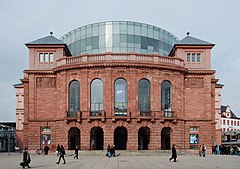Staatstheater Mainz
| Staatstheater Mainz | |
|---|---|

The facade of the theatre, 2010
|
|
| General information | |
| Type | Theatre |
| Location | Mainz, Rhineland-Palatinate, Germany |
| Address | Gutenbergplatz |
| Coordinates | 49°59′58″N 08°16′16″E / 49.99944°N 8.27111°ECoordinates: 49°59′58″N 08°16′16″E / 49.99944°N 8.27111°E |
| Opened | 1833 |
| Design and construction | |
| Architect | Georg Moller |
| Website | |
| www |
|
The Staatstheater Mainz (Mainz State Theatre) is a theatre in Mainz, Germany, which is owned and operated by the state of Rhineland-Palatinate. Situated on the Gutenbergplatz, the complex comprises two theatres which are connected by an underground passage and also by skywalk. Performances of opera, drama and ballet are presented.
The main building was constructed between 1829 and 1833 by Georg Moller in the Neo-Classical architectural style. The construction had been requested by the bourgeoisie of the city of Mainz for decades and cost 280,000 guilders (the city's budget amounted to 300,000 guilders at that time). The theatre's great hall (Großes Haus) was destroyed by bombing during World War II. Friedrich Meyer-Oertel became director of the theatre in 1968. The small hall (Kleines Haus) was built in 1997. Remedial work from 1976 to 1977 aimed at restoring Moller's rotunda were undertaken by Dieter Oesterlen. Between 1998 and 2001, extensive renovations were carried out to restore it to its original condition and it now seats 1,000.
The resident orchestra is the Philharmonisches Staatsorchester Mainz (Philharmonic State Orchestra Mainz).
Before the Staatstheater Mainz was constructed, there existed the theatre "Komödienhaus". The Stadttheater's great hall ("Großes Haus")) was built in 1829-33 by Georg Moller with seating for 1,500. It was inaugurated on 21 September 1833 with Weber's "Jubelouverture" and Mozart's La clemenza di Tito". In 1863, Josef Laske repaired the ducal proscenium boxes. In 1876, the auditorium and the foyer were extended by Eduard Kreyßig. In 1898-99, renovations were carried out by Ferdinand Fellner & Hermann Helmer, which involved creation of additional storage space, alterations to the roof, fixing an iron curtain, and improvements to the heating system. When it reopened on 18 September 1899, Gounod's Faust was premiered.
In 1910-1912, substantial improvements were again carried out by Adolf Gelius such as increasing the foyer space, building an additional floor, modernizing the stage and changes to the auditorium. In 1938-39, the auditorium and foyer were redone after demolition of the 1912 improvements. The theatre was gutted after bombings in 1942. In 1950-51, it was rebuilt to the architectural plans of Richard Jörg with the reopening on 24 November 1951 marked by a ballet performance. In 1977, seating capacity of the auditorium for opera and drama were altered by Dieter Gesterlen to accommodate 801 seats and 887 seats respectively. However, this work was criticized for its acoustical problems, visual effect and seating comfort. In 1989, the theatre was renamed as "Staatstheater". The Kleines Haus (small hall), with a capacity of 500 seats, was built in 1997 by Klaus Möbius and inaugurated on 17 November 1997.
...
Wikipedia
